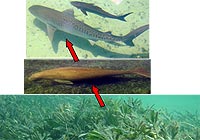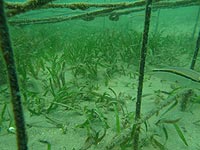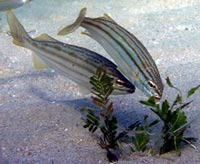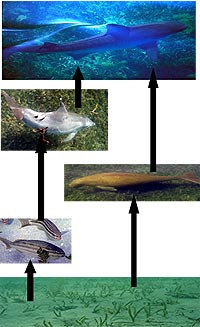
Research Projects – Indirect Effects of Tiger Sharks

Trophic Cascades and Tiger Sharks

communites by changing when, where,
and how large grazers like dugongs
and turtles forage.

along the edge of a bank - outside the
seagrass is grazed down to almost nothing!


sharks could influence seagrass
ecosystems. Do these pathways amplify or
attenuate the overall effects of tiger sharks?
Our exclosure studies should help us find
out! One of the most interesting things
about the possible effects of tiger sharks
on seagrasses is that they occur not
beacuse of the number of dolphins and
dugongs sharks eat, but because of the
behavioral changes that tiger sharks
induce in these two long-lived species.
The past decade of work by SBERP has shown that many species of prey are influenced by the presence of tiger sharks. Dolphins, dugongs, sea turtles, and cormorants modify how they use the habitats of Shark Bay and dugongs change the way they forage (see species pages for more information). But, do these anti-predator behaviors have further effects on the Shark Bay ecosystem? Do tiger sharks cause trophic cascades - where the presence of a predator causes changes at many levels in a food web - similar to those suggested for wolves and other large predators on land? Answering these questions is important for marine conservation in general since tiger sharks, and other large sharks, are disappearing from most of the world's oceans.
Some of our work on patterns of nutrient composition on banks of our study area suggest that tiger sharks do cause changes in seagrasses. The seagrass on the edges of the banks - where sea turtles and dugongs congregate when sharks are around - have lower nutritional quality (high inorganic carbon, low organic carbon content) compared to the seagrasses found in the middle of banks that are largely abandoned by large herbivores when sharks are around. But could changes in grazing patterns induced by tiger sharks help to structure the seagrass community (the amount of seagrass and species present)?
To answer this question, we deployed 2.5 x 3.0m (7 x 10') cages around seagrasses in deep habitats, along bank edges and in the middles of banks. The cages have large (20 x 20 cm) holes in the tops and sides to allow water to flow through them and let fishes get inside but they keep dugongs and green turtles from grazing. Our initial efforts were not terribly successful. Strong currents quickly destroyed our exclosures in deep habitats and shallow ones were damaged in storms during the first year. We also found out that they needed to be cleaned almost weekly! However, owe managed to maintain sets of exclosures and paired control sites for almost three years. Our esults suggest that tiger sharks do indeed influence the seagrasses by changing when, where, and how green turtles and dugongs forage. Check back later for more information on this project!
We also condcted a second round of exclosure experiments that incorporated the effects of smaller herbivores. It turns out that tiger sharks might affect seagrasses in more ways than we thought. Some small fish, like the striped trumpeter, eat seagrasses but these fish are eaten by dolphins, which switch where they forage when sharks are around. By affecting seagrasses through these two different pathways (tiger sharks -> dugongs/green turtles -> seagrasses; tiger sharks -> dolphins/cormorants -> small fish -> seagrasses) tiger sharks may have even greater effects on seagrass communities than we thought. To test this possibility we conducted studies of seagrass preferences by grazers and transplanted fast-growing seagrass species into small fish-proof cages that are inside our larger exclosures. We also have some small cages without two sides (to test what the effect of the cage alone is on the seagrass) inside the large exclosures and planted some gardens outside of the large exclosures that are subject to grazing by all species. It appears that fish are really important grazers, but only in the middle of banks. Taken together our results suggest that tiger sharks affect seagrass beds through both trophic pathways and seagrass beds might be very different if sharks were lost from the ecosystem.
In addition to triggering trophic cascades, tiger sharks mediate indirect interactions among their prey species. In fact, some species in Shark Bay affect one another in ways we would never predict and only do so because they share tiger sharks as a predator. For example, large tiger sharks (>3.5m, 11.5') show up in our study area when dugongs do and these sharks like to spend time in shallow waters where dugongs and their other favorite prey are found. Because of this, dolphins - which are not common prey of tiger sharks and eat fish (not seagrass like dugongs) - almost completely abandon their best foraging grounds in the shallow water. This means that the presence of dugongs actually causes dolphins to leave the areas where dugongs forage! This shows just how interconnected the Shark Bay ecosystem is and suggests that the loss of tiger sharks would have unexpected and negative effects on the rest of the ecosystem.
Relevant Publications
- Heithaus, M. R., A. J. Wirsing, and L. M. Dill. 2012. The ecological importance of intact top predator populations: a synthesis of 15 years of research in a seagrass ecosystem. Marine and Freshwater Research 63: 1039-1050.
- Feretti, F. B. Worm, G. L. Britten, M. R. Heithaus, H. K. Lotze. 2010. Patterns and ecosystem consequences of shark declines in the ocean. Ecology Letters 13: 1055-1071.
- Heithaus, M. R., A. Frid, J. Vaudo, B. Worm, and A. J. Wirsing. 2010. Unraveling the ecological importance of elasmobranchs. In: J. C. Carrier, M. R. Heithaus, and J. A. Musick (eds). Sharks and their relatives II: Biodiversity, adaptive physiology, and conservation. CRC Press. pp611-637.
- Heithaus, M. R., A. J. Wirsing, D. Burkholder, J. Thomson, and L. M. Dill. 2009. Towards a predictive framework for predator risk effects: the interaction of landscape features and prey escape tactics. Journal of Animal Ecology 78: 556-562.
- Heithaus, M. R., A. Frid, A. J. Wirsing, and B. Worm. 2008. Predicting ecological consequences of marine top predator declines. Trends in Ecology and Evolution 23: 202-210
- Heithaus, M. R., A. J. Wirsing, J. Thomson, and D. Burkholder. 2008. A reveiew of lethal and non-lethal effects of predators on adult marine turtles. Journal of Experimental Marine Biology and Ecology 356: 43-51.
- Heithaus, M. R., A. Fird, A. J. Wirsing, L. M. Dill, J. Fourqurean, D. Burkholder, J. Thomson, and L. Bejder. 2007. State-dependent risk-taking by green sea turtles mediates top-down effects of tiger shark intimidation in a marine ecosystem. Journal of Animal Ecology 76: 837-844.
- Dill, L. M., M. R. Heithaus, and C. J. Walters. 2003. Behaviorally-mediated indirect species interactions in marine communities and their conservation implications. Ecology 84: 1151-11567.
- Heithaus, M. R., L. M. Dill, G. J. Marshall, and B. Buhleier. 2002. Habitat use and foraging behavior of tiger sharks (Galeocerdo cuvier) in a sea grass ecosystem. Marine Biology 140: 237-248.
- Heithaus, M. R. and L. M. Dill. 2002. Food availability and tiger shark predation risk influence bottlenose dolphin habitat use. Ecology 83: 480-491.
All photographs copyrighted; Images may be used for educational purposes. For use in other forms contact Mike Heithaus

